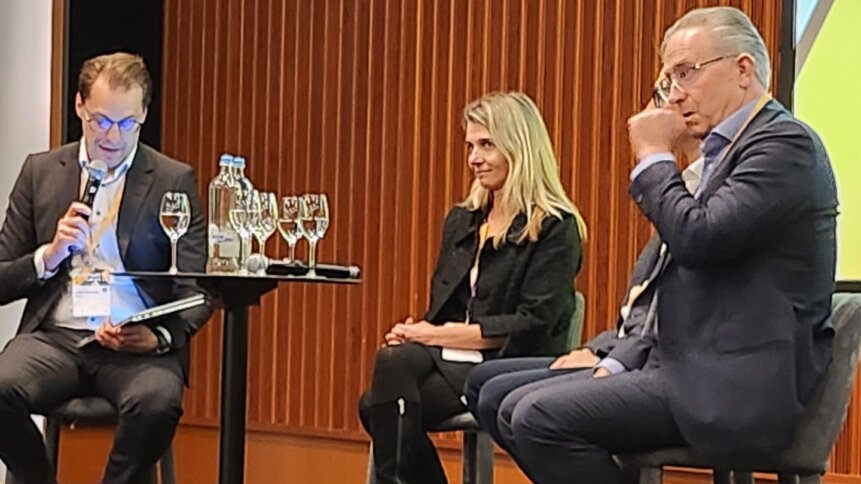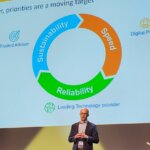Digital infrastructure for energy transition

At the recent Kickstart Europe 2023 conference in Amsterdam, the great and the good of the European data center industry were focused on an important question – how to keep delivering data centers and digital infrastructure at the rate at which they’re needed, while also driving them towards better and greener energy outcomes.
One panel in particular, chaired by Jussi Vihersalo, Business Development Manager at Eaton Corporation, brought Natasha Geraedts, a partner at Eversheds Sutherland, Eric Lisica, Operations Director Europe at Iron Mountain, and Nicola Corradin, Product and Strategic Marketing Manager, FIAMM, together to discuss the rock vs hard place equation of more demand for data centers, and significantly rising resource costs – particularly when it comes to the energy that data centers gulp like a cold soda on a hot day.
Could there be a workable solution to this pincer movement on the development of new data centers?
Face your challenges.
The chair first threw out a critical question to the whole panel – what kind of challenges or opportunities could they see for data centers related to the energy system in the short-term future?
Eric Lisica laid out the groundwork of the problem – increased demand for data centers, but what he called increasing challenges with regulation. He identified potential opportunities to help sweeten the data center deal with the likes of re-use of generated heat – something that’s already been tried in the UK, for instance, to heat local swimming pools. If data center operators were smart in the short-term future, said Eric, “the way we procure and utilize power in our data centers will allow us to reduce our costs.”
Nicola Corradin saw opportunities in grid services, in that data centers could become only users of energy and players in the integration and support of local or national grids. That way, the data center operator would not only be paying the bill for the energy used, but that same energy could also generate revenue by contributing to the stability of the grid.
“As a technology supplier, it won’t surprise you when I say that new technology bring new ways to utilize data centers,” he added. “It brings new ways to think about solving our problems. The technology is already there.”
When asked what kind of technology he meant, Corradin explained that, for instance, he was including things like new batteries with longer lifespans, higher temperature acceptance, and a greater tolerance for cyclical behavior. These, he suggested, could help support the grid integrity.
“Our industry is very energy intensive,” he acknowledged, “so we’re looking for ways to reduce our impact when we manufacture batteries. For example, we’re utilizing recycled materials in that process.
And also, we’re making sure the batteries can be recycled at the end of their lives. So, while it’s not really directly relevant to the impact of a data center to the grid, it does reduce the global footprint of what we do as a supplier to this industry.”
Getting the message out.
Jussi Vihersalo raised the point that the data center sector frequently appeared to be on the back foot, with a perceived need to defend itself. “But data centers and digital infrastructure and the energy transition are not separate things,” he explained. “They are the same – there is no energy transition without digital infrastructure and data centers. And that’s something we miss out in discussions.
“Let’s get that message across more. A lot of people are involved in working groups, and also with the Ministry of Economic Affairs, at least in the Netherlands, but can we get that message more widely heard in the world?”
He threw the challenge to Natasha Geraedts. “What needs to happen to move us from vision on all this to real action, so we start seeing data centers or digital infrastructure that is better supporting the energy transition? What needs to happen around the whole data center ecosystem?”
An holistic approach.
“There’s always a fear that if you make a plan too big, that it’s not going to be executed because it’s too complex,” said Natasha. “But you have to start by using an holistic approach. We need a plan, and we need to get all the right stakeholders around the same table. Just to mention one small example with regard to emergent escalation for battery storage, the Ministry of Interior Affairs was not involved in the beginning, and we only saw one other ministry involved.
“That was already a big step. I think you will meet others to implement the necessary legislation, and to make it workable for businesses. So we need to plan and we need the right people at the right table, rather than to be competing for individual aspects or individual goals. Securing the electricity is extremely important, and there are ways to overcome that. Larger organizations always have ambitious decarbonization goals, but those are not always easy wins.
“Energy in general has become extremely important, and it’s embedded in authorities and policies.”
Nicola Corradin added that while the industry should be aware and proactive about its technology, it needed a step forward to make progress, rather than relying on a one-size-fits-all approach.
“Authorities are moving at a different speed,” said Eric Lisica. “We need to align with them to move in the same way at the same speed.”
So a combination of taking advantage of the opportunities available, making the most of the opportunities to “green” the technology in use, and getting around the right tables with an holistic approach were judged to be the top priorities when it came to the data center industry with regard to energy transition in 2023.










